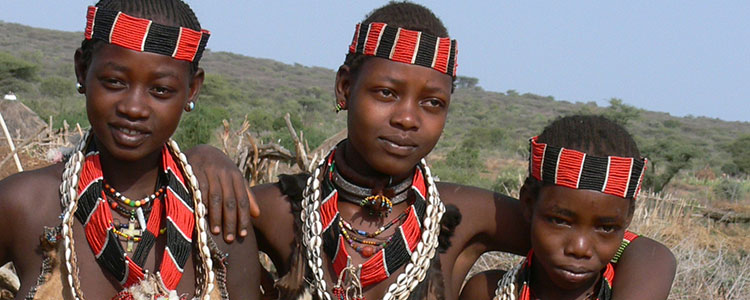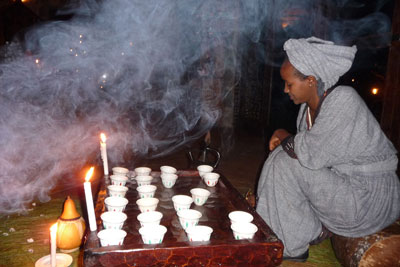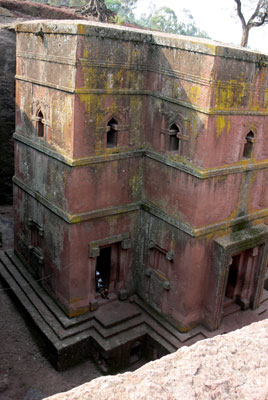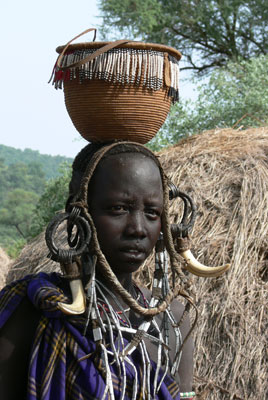Encountering the unexpected in Ethiopia
by Regine Schumacher; Seal Beach, CA
“Travel Ethiopia and be seven years younger” was the slogan of our tour offered by Geographic Expeditions (San Francisco, CA; 800/777-8183). They were actually correct, in a way. Ethiopia’s calendar, like the Julian calendar, is about seven years behind ours. Unfortunately, my Gregorian-calendar body was as exhausted as could be after the long flight from Los Angeles to Ethiopia’s capital, Addis Ababa.
A nice beginning
After being pampered at the Sheraton, our group was off for a day of sightseeing and museum visits before flying to Bahir Dar near Lake Tana, the source of the Blue Nile. A lengthy boat ride took us to an island, where we climbed endlessly on a slippery path to an incredible monastery sheltering treasures of the Ethiopian Church.
The next day we were off to Gondar, stopping on the way at a settlement (more or less a commune) that was self-reliant, had no emphasis on any particular religion and was a prime model of equality between men’s and women’s work in this usually male-dominated country.
This community had built school and library buildings out of mud, and there was an old-age home where the people seemed well cared for. Women were spinning thread and men were weaving. They even had a small, primitive building for visitors and guests.
The seven of us paid a total of 30 cents to visit. We were invited for some Ethiopian coffee, which, by the way, was incredible — very strong but never bitter. Ethiopia is one of the birthplaces of coffee and still produces some of the world’s finest beans.
Then we continued to Gondar. From there we took a drive to the Simien Mountains. I was astonished to find out that these mountains have dozens of peaks higher than 12,000 feet.
And that is where our prearrangements ended. A volcano erupted in Eritrea and spewed so much ash into the air that all air traffic was stopped within Ethiopia as well as in parts of Sudan and Egypt.
Making adjustments
We had to drive to Lalibela, forgoing our planned visit to Axum (where the Ark of the Covenant is reputed to be). It was a miserable trip for many hours over rutted and dusty roads, but one has to be flexible and there was no alternative. It did give us an opportunity to see more of the rural areas.
There was so much poverty. I saw undernourished people living in tiny huts; children tilling fields of mainly rocks with wooden plows; little boys herding livestock, and old women carrying huge loads of firewood or water on their backs for miles. The people and their children, most of whom were very handsome and had an inborn dignity, were pleasant and cheerful, waving at us as we passed by.
Stiff and cramped, we arrived in Lalibela, a strange and isolated town. This is one of Ethiopia’s holiest cities and a center of pilgrimage for much of the country. Its population is predominantly Ethiopian Orthodox Christian.
Lalibela’s churches are hewn into the solid, red volcanic rock below ground level and connected to each other by a tangled maze of tunnels and passages. There are about 11 churches in the town, among them Bete Emanuel, a 36-foot-high monolith.
Church services are three hours long. One has to stand, with only a pole on which to lean.
Air traffic had not yet resumed, so we had to drive for two days in a cramped van in order to get back to the capital, again on torturous roads, staying in a “best available hotel” midway. Needless to say, it was very primitive.
Back on track
Arriving back at the Sheraton in Addis, we luxuriated in all its modern conveniences. By this point, I didn’t feel seven years younger.
Great news, though! Air traffic had resumed, so the next day we were off to the south by plane, eliminating what would have been another 2-day drive.
Now things got really primitive, but that was as expected. Our prime purpose for traveling to the area was to visit the Omo Valley. This vast, thinly populated part of the world remains one of the wildest in Africa.
The Lower Omo is home to many traditional agropastoralist tribes, including the celebrated Mursi, who are best known for their decorative lip plates.
I personally would describe our visit as having arrived in the Stone Age. This is no exaggeration! I saw hardly anything made of metal, except for the rifles most men were carrying; utensils were made of clay and cow horns.
Each village had its own traditions and styles of dress (or lack thereof). To visit them required lengthy drives on more dirt roads.
While at a market, we heard that a rite of passage was going to be held nearby. This was a unique opportunity for us, but it was not easy to stomach. When a boy comes of age, he has to sprint, stark naked, over the backs of several cattle while the women of the tribe are whipped, their pain an expression of their love and affection for the young man on his way to adulthood.
The women then danced and chanted, stomping the ground and kicking up dust. Bells attached to their legs were jingling while blood and sweat were running down their backs. It was quite a surreal and unnerving experience, and I thanked God that I had been born elsewhere.
While in the Omo Valley, we visited most of the different tribes, heard a lot of tales and saw a lot of rituals, ornate body art, body scarification (an expression of beauty and status within the community), body and face painting and, of course, the different hair styles.
At the Mursi village, the women wear circular clay plates in their lower lips. The larger the lip plate, the greater the woman’s value when she is married.
At one village we encountered a shaman who was reputed to tell fortunes. For a small fee, he repeatedly slapped an old pair of sandals together, threw them on the ground and then told a fairly positive but ambiguous fortune.
Our experiences with these incredibly rich and proud, yet adapting, cultures gave amazing insight into Ethiopia’s indigenous peoples.
It was a truly unique and unforgettable experience that was certainly worth our hardships, which seemed insignificant after all we had seen.
The details
My “Ethiopia: The Island of Africa” tour (June 10-25, 2011) cost $9,385, including a single supplement and an early-booking discount. International airfare was an additional expense.




